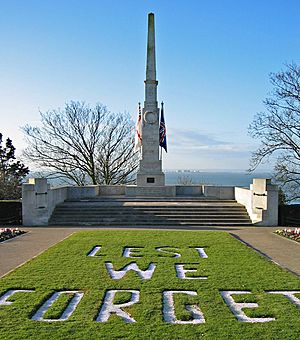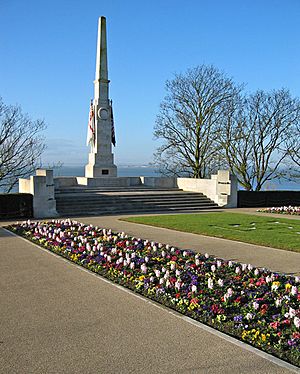Southend-on-Sea War Memorial facts for kids
Quick facts for kids Southend-on-Sea War Memorial |
|
|---|---|
| United Kingdom | |
 |
|
| For men from Southend killed in the First World War | |
| Unveiled | 1921 |
| Location | 51°32′03″N 0°42′18″E / 51.53423°N 0.70495°E Clifftown Parade, Southend-on-Sea, Essex
|
| Designed by | Sir Edwin Lutyens |
|
Listed Building – Grade II
|
|
| Official name | Southend-on-Sea War Memorial |
| Designated | 23 August 1974 |
| Reference no. | 1322329 |
The Southend-on-Sea War Memorial is a special monument in Southend-on-Sea, Essex, on the east coast of England. It was built to remember the brave soldiers from Southend who lost their lives in the First World War. A famous architect named Sir Edwin Lutyens designed it. This memorial is so important that it is a Grade II* listed building, meaning it's a very special historical site.
Sir Edwin Lutyens first thought about designing a different type of memorial, like a cenotaph (a monument for people buried elsewhere). He had designed a very famous one in London called The Cenotaph. However, the Southend memorial ended up being an obelisk, which is a tall, narrow stone pillar. It has stone flags on its sides and is surrounded by a low wall. Steps lead up to it from the north. The memorial was officially revealed on 27 November 1921. A person called Lord Lambourne, who was the Lord Lieutenant of Essex (a representative of the King or Queen), unveiled it. The Bishop of Colchester also dedicated it.
Contents
Why We Have War Memorials
After the First World War ended, many towns and cities across Britain built war memorials. These monuments helped people remember the soldiers who had died. Sir Edwin Lutyens was one of the most important architects who designed these memorials. He is known as one of the best English architects of his time.
Lutyens designed many famous war memorials. These include The Cenotaph in London, which is where national Remembrance Sunday events happen. He also designed the Thiepval Memorial to the Missing in France, which is the biggest British war memorial in the world. Another of his designs is the Stone of Remembrance, found in many large cemeteries for war graves. The Southend memorial was the first of six memorials Lutyens designed in England that featured an obelisk. Its design is similar to the North Eastern Railway War Memorial in York.
What the Memorial Looks Like
The Southend War Memorial is a tall, pointed stone pillar called an obelisk. It is made of Portland stone and stands about 11 meters (36 feet) high. The obelisk sits on a square base with a decorative top. The bottom part of the memorial sticks out from the low walls that surround it on three sides.
To reach the front of the memorial, you walk up six wide stone steps. On either side of these steps, there are carved bases with bronze supports for flags. Near the bottom of the obelisk, there is a carved laurel wreath, which is a symbol of victory and honour. Painted stone flags rise from the base on either side of the wreath. The Union Flag (the British flag) is on the west side, and the White Ensign (the flag of the Royal Navy) is on the east.
The memorial is placed in a great spot at the top of a cliff, with the Thames Estuary (where the River Thames meets the sea) right behind it. In front of the monument, there is a garden also designed by Lutyens. The words "LEST WE FORGET" are written into the grass in stone letters. Paths and flower beds surround this area.
Messages on the Memorial
The memorial has a lot of writing on it. Above the flags and the laurel wreath, you can see the dates of the two world wars:
- MCM XIV / + / MCM / XIX (1914-1919 for the First World War)
- MCMXXXIX / + / MCMXLV (1939-1945 for the Second World War, added later)
Below the laurel wreath, it says:
- "OUR / GLORIOUS / DEAD"
At the very bottom of the main part, it explains why the memorial was built:
- "THE NAMES OF THE 1338 MEN OF / SOUTHEND-ON-SEA / IN HONOURED MEMORY OF WHOM / THIS MEMORIAL / WAS ERECTED BY GRATEFUL RESIDENTS / ARE RECORDED UPON A TABLET / PLACED IN THE REFECTORY AT / PRITTLEWELL PRIORY"
This means the names of the 1,338 men from Southend are on a special plaque at Prittlewell Priory, which is a local museum.
The last message at the very base of the memorial is a famous line from a poem by Laurence Binyon called "For the Fallen":
- "AT THE GOING DOWN OF THE SUN / AND IN THE MORNING / WE WILL REMEMBER THEM"
Two more plaques have been added over time. In 1998, a metal plaque was put on the base. It says:
- "THIS PLAQUE IS DEDICATED TO / THE MEN AND WOMEN OF SOUTHEND / WHO HAVE SERVED THEIR COUNTRY / IN ALL WARS AND CONFLICTS / TO PRESERVE PEACE AND FREEDOM / FOR ALL. / WE WILL REMEMBER THEM / FUNDED BY SOUTHEND-ON-SEA BOROUGH COUNCIL / ON BEHALF OF THE ROYAL BRITISH LEGION (SOUTHEND BRANCH)/ 1998"
Another plaque was added by the Association of Jewish Ex-Servicemen and Women (AJEX). It reads:
- "AJEX / SOUTHEND & DISTRICT BRANCH / IN MEMORY OF OUR FALLEN COMRADES / WHO GAVE THEIR LIVES IN THE SERVICE/ OF THEIR COUNTRY"
History of the Memorial
The Southend-on-Sea War Memorial was officially opened on 27 November 1921. A large crowd gathered for the ceremony. Amelius Lockwood, 1st Baron Lambourne, the Lord Lieutenant of Essex, unveiled it. The Right Reverend Dr John Watts Ditchfield, who was the Bishop of Chelmsford, dedicated the memorial. Soldiers from the Essex Regiment also formed a guard of honour.
On 23 August 1974, the memorial was given a Grade II listed building status. This means it was recognized as an important historical building. In November 2015, during the 100th anniversary of the First World War, all of Lutyens' war memorials in England were reviewed. They were recognized as a "national collection" because they are so important to the country's history. As a result, the Southend memorial's status was upgraded from Grade II to Grade II*, showing it is even more historically significant.


